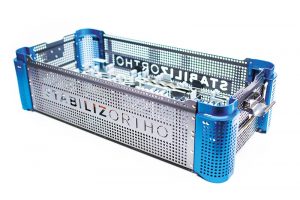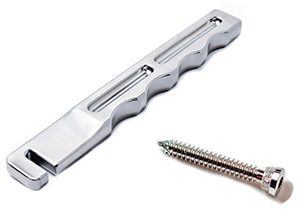When Doug, Brad and Mike are together, the chemistry is clear.
The three alumni share a brotherly ease as they poke fun of each other’s clothing, music taste and work ethic. All are fathers of young children, and when they’re not talking business they swap childcare questions and tales of toddler night terrors. They’ve been close for eight years, ever since meeting as students in LeBow College of Business’ two-year MBA cohort program, and in the years since graduation, they have been either “too stubborn or too stupid,” they say, to give up on a dream they began as grad school pals. With their mix of expertise in medicine, business and biomedical engineering, they each bring something essential to the product they’ve carefully built — and together, they stand nervously, excitedly, at the brink of going commercial.
The trio are the founders of Stabiliz Orthopaedics, a nascent medical device company whose fortunes turn entirely on the success of a small, deceptively ordinary-looking screw.
Their uniquely designed screw is the most crucial component of an orthopedic bone-healing system that allows for micromotion — that little bit of movement that helps bone fractures to fully heal. Combined with a kit of complementary surgical tools, the Stabiliz product line aims to make operations easier for orthopedic surgeons, more successful for patients and less costly overall.
Their target date to introduce the kit to the market is spring 2016. If the concept catches on with doctors, the company can claim a coveted place as the provider of choice in the world of bone trauma medical devices, a $6 billion global industry.
A List of Ideas
Stabiliz began with a few ideas jotted on a sheet of paper.
It was fall 2008 and the annual business competitions hosted by LeBow were approaching. Winners receive cash, publicity and office space in what is now the Baiada Institute to further develop their ideas.
At the time, Doug Cerynik, MD, was in his first year as a student in Drexel’s LEAD MBA program, taking evening classes while serving as the director of orthopaedic research in the Department of Orthopaedic Surgery at Drexel’s College of Medicine.
Leading up to the competitions, Cerynik did his homework. He asked his clinician peers what limitations they faced in the operating room and what technologies they needed to improve their outcomes — and one discussion in particular stood out.
One surgeon colleague, Susan Harding, expressed concern with plate-and-screw implants commonly used to set bone fractures. The most common plate-and-screw implants on the market hold bones together rigidly, and while that’s good in the early stages of a traumatic bone fracture, later, it interferes with bone regrowth.
Bones, Harding explained, require a tiny bit of movement to heal well. This micromotion is so essential to healing that surgeons frequently have to conduct costly and invasive follow-up operations in order to fix the problems created by rigid plate-and-screw systems. Her insights gave Cerynik an idea (and helped to earn her the title of co-inventor).
“If a bone is held apart very rigidly, the bone thinks it’s healed,” Cerynik explains. “The ideal implant would initially hold the broken bones rigid, and then loosen up over time.”
A majority of the nearly two million bone fracture patients treated in the United States annually are implanted with locking plate-and-screw systems, which are the most popular type because they provide the most stability. However, because too much rigidity is an obstacle to healing, some doctors prefer non-locking plate-and-screw implants, which allow bones some movement, but at the expense of the stability needed early in the healing process. No device currently exists on the market that starts rigid and loosens over time.
One surgeon’s story, in particular, fascinated Cerynik. His colleague Anjan Shah, a graduate of the College of Medicine’s Orthopaedic Surgery Residency Program and now a practicing trauma surgeon in Tampa, told him that he considered wrapping human tissue around the head of an orthopedic screw to artificially introduce micromotion into the fracture. Shah theorized that the tissue would gradually allow for some movement, adding more credibility to Cerynik’s concept.
Was it possible to attach a biodegradable polymer collar to the screw that could safely resorb back into the patient’s body over time, Cerynik wondered? Although rigidly locked with the plate at first, the polymer would gradually provide a cushion and some flex — a potentially game-changing improvement over existing locking screw systems.
It was an idea that had promise, and seemed marketable, at least to Cerynik’s classmate Brad Grossman, who would go on to become Stabiliz’ vice president of marketing. Cerynik approached Grossman because he liked his style: an outspoken go-getter with an “entrepreneurial mind.”
Grossman, when not working for Stabiliz, serves as the vice president of marketing and development for Helium Comedy Club, which has locations across the United States including Philadelphia. Before that, he was the owner and operator of a marketing agency in Cherry Hill, New Jersey.
“I saw an opportunity with a simply designed product that could have significant impact on the way clinicians operate, not to mention the size of the win if we’re acquired,” says Grossman.
To complete the team, both Cerynik and Grossman said, “I know a guy.” Grossman brought in Mike Adelizzi, who had experience working for medical devices companies, to serve as the company’s vice president of research and development. Another classmate with financial expertise was initially a fourth team member but is now a silent partner.
“If you have a difficult fracture, you don’t want to mess around. You want to get what you need into that bone as soon as possible.”
They entered their idea into the Baiada Incubator Competition and won, netting them $12,000 in seed money, more than $35,000 in in-kind support and designated space in Drexel’s Baiada Institute for Entrepreneurship, an incubator for businesses formed by students and recent alumni. As a bonus, they also won the first-place prize of $3,000 in what is now called the Ian J. Berg Business Plan Competition.
More importantly, Stabiliz won the attention of Ben Franklin Technology Partners (BFTP), one of the oldest tech private-equity organizations in the country with influence in the world of Philadelphia venture capital.
With three separate fundings totaling approximately half a million dollars, BFTP is Stabiliz’ largest single investor.
Backing Stabiliz’ vision was a no-brainer, says Jennifer Hartt, director of investments in life sciences for BFTP.
“We think this team’s thinking is very innovative in terms of unmet needs and healing times,” Hartt says. “The reality is that poor healing has a lot of collateral damage in people’s lives, so even incremental improvements are things we want to see. As investors, we want to see an impact on health, and we want to see that here in the region.”
A Product with Potential
There’s nothing easy about entering a multibillion dollar industry already filled with mature players. Naysayers were everywhere. Manufacturing flops by larger and better-funded companies were daunting reminders of the risk. But bone healing failures, including non-unions, jeopardize up to 30 percent of all plated fracture surgeries, so the Stabiliz team pressed on.
Conceptually, their polymer locking mechanism is very simple. But actually making a prototype was not. It was a challenge even to find the right manufacturer. Once the team made a selection (it’s a Pennsylvania-based company, by the way), they spent another two years perfecting the design.
“Design it, build it, test it, make corrections, design it, build it and test it again,” Cerynik says of the process.
“We struggled in the beginning,” says Adelizzi. “We had some early prototypes of this product where the polymer collar would fail fairly easily. But, through a little ingenuity… we went back and continued redesigning, so now the polymer is firmly fixed to the screw.”
The Stabiliz team was not the first to come up with the idea of incorporating bioresorbable parts into metal plates and screws, though they may prove more successful than large corporations that have tried. While the Stabiliz team was busy perfecting their product, both Zimmer Biomet and DePuy Synthes (a division of Johnson & Johnson) brought to market their own solutions to address the problem.
The Synthes product has undergone two recalls since it launched, and the Zimmer product is, according to Cerynik, more difficult to implant and leaves larger holes in healthy bone.
“These systems are attempts at solving the same problem that we are trying to solve, only we think we are solving it in a better way,” Adelizzi says. “One of our key differentiators is that our system changes its mechanical properties over time — theirs are static and behave the same from day one to infinity.”
The Stabiliz team has more motivation to succeed than big medical device companies, says Cerynik.
“The large players have hundreds of options for new products on the table,” he says. “They fiddle with some for a few minutes, and if they don’t get anywhere, they move on quickly. They are very risk-averse — they throw new product development, all ingenuity, all risk taking onto the new little companies like us.”
For now, the team is focused on addressing needs in the industry for adult long bones (for example, the tibia, or shin bone). In the future, their system could have an impact in treating children and adult cases where bones are small — such as in the wrists, hands and feet.
“In children, the hardware often comes back out,” says Cerynik. “When you thread polymer into a metal plate, it’s far easier to remove than a metal screw threaded into a metal plate. This is important because implants for treating fractures in children are often removed — potentially a long and challenging operation.”
Besides being easy to remove, another advantage of Stabiliz’ system is the possibility of polyaxial locking, which means you can put the screw in at all different angles and lock it into place — which is often done in small bone surgery.
The founders have already been approached about a possible licensing deal with a U.S. company that markets plate-and-screw implants for the foot.
“Strong interest has been expressed in using our products,” says Cerynik. “There is a vast network to tap for expertise and users.”
A Rolodex of Dragons
The most important step toward commercialization is user adoption.
“We had to start generating interest on the surgeon level,” Cerynik says. “Credibility is built when investors see users adopting it.”
How do you get surgeons, who turn away pesky sales reps by the dozen, to buy in? You call on your colleagues and fellow alumni.
The team has spent this year introducing the kit to surgeons with whom they already have relationships, including some of Cerynik’s former colleagues from the College of Medicine.
“I get reps showing me new products every day, but this is something that’s different from everything else on the market,” says Shah. “The science behind it makes a lot of sense. The technology developed and used by Stabiliz has real promise and is truly a potential game changer.”
“I’ve had a chance to play with some of the instruments and it’s about minutes and convenience,” Shah adds. “If you have a difficult fracture, you don’t want to mess around. You want to get what you need into that bone as soon as possible.”
Nirav Amin, a Drexel College of Medicine alumnus and graduate of the College of Medicine’s Orthopaedic Surgery Residency Program and now an orthopaedic surgeon and associate professor at Loma Linda University Medical Center in California, also sees the surgical tools as potential time savers in the operating room.
“Let’s say there is a five-minute delay just handing instruments back and forth, looking for the one you want; if you are doing six cases a day, that could add up to a couple of hours of your day,” he says.
Other surgeons, former colleagues and fellow alumni have expressed interest in the system.
“The other day, I tried to make a list of all the contacts we have made thus far, and it was well over 100,” Cerynik says. “And that’s just our extended Drexel network.”
One of Stabiliz’s biggest hurdles has been fundraising. They’ve built a business; now they need the inventory.
Over the past few years, the team has made countless phone calls, sent innumerable emails, knocked on doors, and asked for big-time favors from family and friends, all while starting families.
In 2014, Cerynik took the leap of quitting his day job, so to speak, to work full time at Stabiliz. Later that year, Adelizzi joined him.
“In order to actually bring this thing to market, you have to put in more than a full-time effort,” Cerynik says. “I had been full time for about three quarters of the year, and I was overwhelmed by the weight of the work. I needed more help.”
“It was scary,” Adelizzi recalls. “I left the best-paying job I had ever held. Luckily, my wife was super supportive; there were moments where I was terrified and freaking out and she was the one telling me it was going to be OK. But I knew Doug would drown if he had to do it on his own.”
A LeBow Bond
All three partners agree that what has kept their dream going is their ability to mesh personally and professionally — the LeBow MBA cohort approach in action.
What drew them to the accelerated MBA program at LeBow wasn’t just a desire for a little extra career development — a better job, or maybe more money. Rather, they really wanted to do something big, and their Drexel bond made it possible to follow through. Now as they face the next challenge, their connections with other alumni are key to their startup plan. And they’re already thinking ahead to the day when they can hire Drexel co-op students.
“I think this would just be an idea unless I’d met these guys in the business school,” says Cerynik. “We all wanted to do something different from our current careers and we wanted to push the envelope a little. We were able to form a cohesive team, bring our individual talents, and we were able to develop those skills within LeBow. We are a group of people who met in business school and actually accomplished something.”
The Kit
By 2011, the Stabiliz team had a polymer-melded screw design that worked. But their vision was larger. Along the way, the team created an entire complementary kit of instruments that surgeons are already talking about.
The Stabiliz kit is a super sleek, futuristic metal box housing implants and instruments that simplify and improve on locking plate-and-screw systems already on the market.
What’s most appealing, says Cerynik, is that none of the tools and devices is anything drastically new. That means no additional training for surgeons. The plate-and-screw components are what surgeons are already used to, only better.
The team added grips to some tools and reduced the weight of others for easier handling, for example, and redesigned some common tools so that surgeons had fewer components to deal with overall.
“We tried to streamline and combine multiple instruments down into a couple and refine them. With less parts, less things break or get lost,” says Cerynik. “We’ve made a lot of the tools multi-functional — you use it one way, flip it over, and use it another way.”
For example, a typical kit contains many differently sized depth gauges, the tool used to measure the depth of the hole in the bone that’s been drilled for the screw. Surgeons often have to use up to three or four separate gauges in a single operation. So Stabiliz designed one tool that combines the features of multiple gauges.
“When you’re in an operative environment, everything is slippery and difficult to hold,” Cerynik says. “We wanted to make it easy
to use.”






